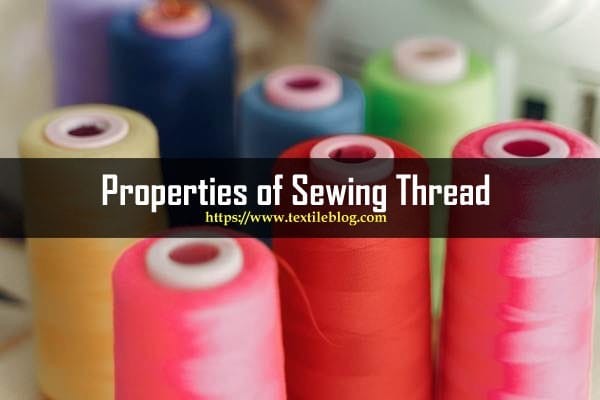What is Sewing Thread?
Sewing thread is an important trimming which ensures the functional and aesthetic properties of apparel or any garment product by securing the seams. It is one type of yarn that used to combine two or more pieces of fabric to produce garment. The basic function of a sewing thread is to deliver aesthetics and performance in stitches and seams.

There are threads of many companies in the same size, same type and in same color. For the thread of a specific size, to determine which will be the best one among the different companies of threads, is a little bit hard job.
Functional and Aesthetic Properties of Sewing Thread:
For selection of a good thread, the properties of sewing thread that may be reviewed are described below:
1. Tensile strength:
The strength that is required for pulling and breaking of a thread is called the tensile strength. It is generally expresses in gram, kilograms or in pound. Due to temperature, water vapor, the rate of application of force and the strength of the thread, tensile thread may vary slightly. In order to determine the difference of strength of the threads of the same size or of same ticket number, tensile strength is found out and considered.
2. Tenacity:
Tenacity of a thread is obtained by dividing the tensile strength of thread by its count or thickness. The tensile strength of thread depends on its count, this means that greater the thickness of a thread, so will be the tensile strength. The tenacity of thread is not dependent on its count, because it expresses the strength of unit thickness of thread. As a result, the difference and superiority of strength between the threads of various counts or numbers can be judged by tenacity. Tenacity, generally is expressed as grams per denier or grams per tex.
3. Loop strength:
The process of making of loop of one thread through the loop of another thread and taking equal the length of two loops and determination of loop breaking strength is called the loop strength. The strength of a thread is supposed to be low in the loop part and if it breaks at that part, only then it will be considered in determination of loop strength, but if it breaks at any other place, then it will not be acceptable. The two loops should be with the same thread. The loop strength is closely related to the stitch strength of a thread. The superiority of a thread can also be judged by comparing the loop strength between two threads.
You may also like: Sewing Thread Consumption Guide for Professional
4. Loop strength ratio:
The ratio between the strength of a thread and the loop strength of that thread is called the loop strength ratio. The highest value of this ratio may be 2. This is used for determination of efficiency of the strength of a thread in the stitches.
5. Minimum loop strength:
The strength of the weakest loop, among some successive loops is called the minimum loop strength. For understanding the performance of thread among the successive stitches of a seam, ‘the minimum loop strength’ is used.
6. Elongation at break:
During the time of breaking of the thread due to the application of force on it, the length which is stretched beyond its original length is called the elongation at break. It is generally expressed in percentage. It is very much important in case of the extensibility of a seam.
7. Stretch/Strain curve:
The curve which is got by drawing the elongation of thread against the increasing tenacity on it is called the stretch/train curve. Different curves are obtained for different threads. For determining of comparative standard of two threads, this curve is the most suitable system.
8. Elasticity:
That which extents in length during pulling and returns to its original length when pulling is withdrawn is called elastic. That which extents in length during pulling but does not return to its original length when pulling is withdrawn is called plastic. Most of the sewing threads are at somewhere in the middle of elastic and plastic. The elasticity of thread is very much important in case of sewing of the knitted fabrics.
9. Shrinkage:
Due to heat or washing with water, the amount that a thread shrinks from its original length is called the shrinkage. It is expressed in percentage (%). If the sewing thread shrinks, it creates seam puckering.
10. Abrasion resistance:
The abrasion resistance of a thread is very much important for judging its sewing performance. In this case, the abrasion resistance of a thread is considered with the abrasion resistance of another same thread. With the help of specialized system and machine, this test is done.
You may also like: Various Factors Influence Sewing Thread Consumption
11. Colorfastness:
The color and the shade of the thread selected, is expected to remain unchanged till the natural life time of the garment. But practically, if it does not happen, then problem may be created. Fast color means it will not go or burn in washing or in sun light or color will not adhere to fabrics from the thread along the sewing line. In case of judging the quality of thread, it should be ensured through tests about the colorfastness of the thread.
